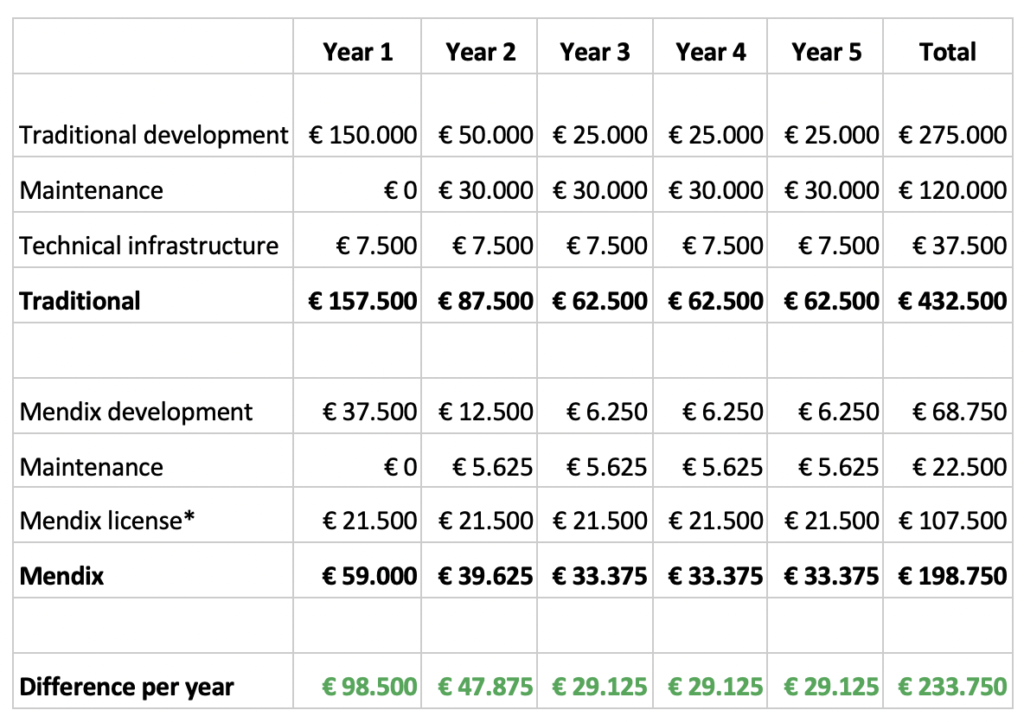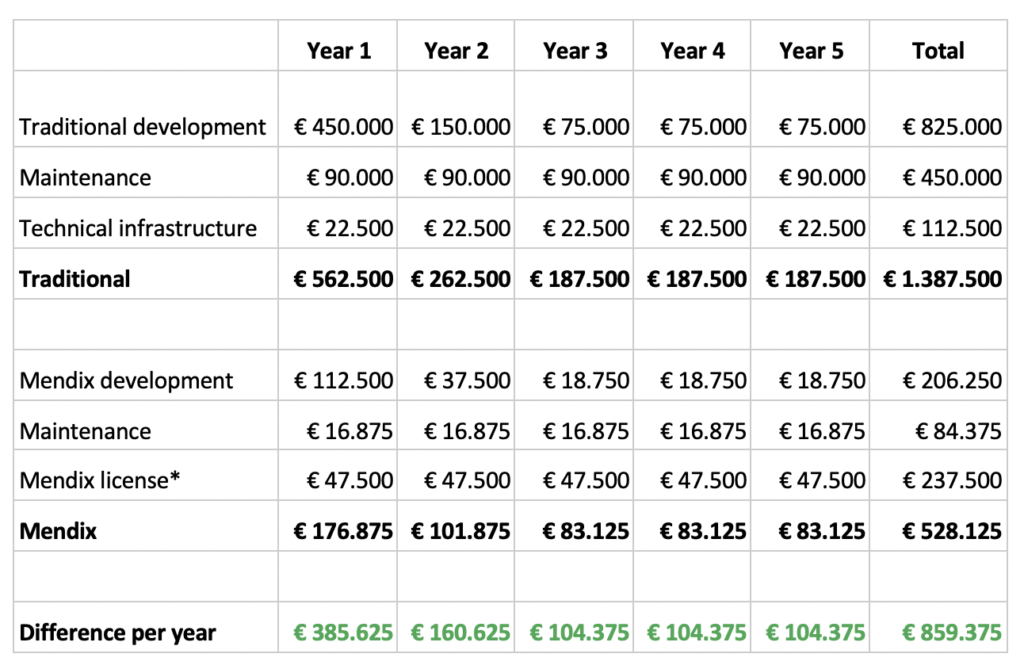The low-code investment

The world of low-code is growing exponentially. Gartner predicts that by 2024, 65% of all applications will be created using low-code technology*. When evaluating low-code as a means for application development, a few things to consider include:
- The value of low-code in terms of speed
- Collaboration between business and IT
- The Total Cost of Ownership (TCO)
In this blog we will briefly explain what low-code is and how investing in low-code will result in a lower Total Cost of Ownership.
What is low-code?
Low-code development is a method of developing applications that use visual models and graphic workflows instead of manually writing lines of code as with traditional programming languages. This visual way of developing applications has the following benefits:
- The models are understandable by non-IT people, so business and IT can work together, yielding better results
- Application development goes much faster, according to Forrester, low-code development is 6 to 10 times faster compared to traditional application development (Forrester Total Economic Impact of the Mendix Platform June 2020)
- Low-code development teams are small, which means the cost of developing applications is lower
The TCO of low-code applications
Let’s take an average size project. A purchase order management application that provides insight into the progress of purchase orders and integrates with an ERP and Warehouse Management System. The application is used by several different user types all with access to different overviews and dashboards.
Four critical factors impact the investment in the development of this application: development time, infrastructure, maintenance cost during the full lifecycle of the application and the value of the end result.
Development time
The apparent impact of working with low-code is that less time is needed to develop an application. Let’s be conservative and assume an increase of four times in development speed when using the low-code platform Mendix. When the cost to create the application using traditional development is € 150.000, the shorter development time with Mendix would result in a cost of € 37.500.
Maintenance cost
Once an application goes live, it needs to be maintained. This regular maintenance ranges from security updates to small improvements and minor changes. In general, the yearly maintenance costs of a traditionally developed application are 20 percent of the development cost (CIO.com). Maintenance with Mendix is easier due to the nature of low-code technology. Our extensive experience shows an overage maintenance cost of 15 percent of the already significantly lower initial investment.
Infrastructure
For each application, you need a technical infrastructure to run an application. Besides that, there needs to be a set of tools in place to facilitate the development process and monitor the application once it goes live. The infrastructure is typically acquired from major cloud providers or can be custom built. Either way, this infrastructure comes with a cost, typically around five percent of the initial investment in an application.
With Mendix, one engages in an annually recurring license fee to use the platform which includes all the necessary infrastructure to run and monitor the application. It also includes the tools for the entire application development process.
The value of the end result
The last factor which impacts the value of investing in low-code is the most important. When working with low-code, the business is much more involved during the development of the application. Because of the nature of low-code, business analysts and end-users can understand how the application is created and can provide direct feedback and even participate as citizen developers during the entire lifecycle of the application. This results in applications that are a much better fit with what the business needs.
The complete investment
Let us combine all these insights into a multi-year budget where we compare traditional development with low-code. In this summary, based on our experience, we assume that after the first year, the application extends with new functionality, based on experience gained while using the application extensively. In the following years, the investment in new features will decrease, but they will still be there due to changing market dynamics, new rules and regulations, etc.
The following overview shows a multi-year comparison between the investment needed to develop our example application with traditional development versus low-code. The benefit of using low-code is already visible after the first year and will accumulate to more than € 230.000 over five years.


As you can see, the low-code investment makes sense if you look at the long-term value. The license fee for the low-code platform pays for itself by lower maintenance and infrastructure costs. The TCO of the application after five years, when built with low-code, is 54 percent less than that of traditional development. This does not even consider that the business is much more involved during the development with Mendix, which results in an application that has more business value.
In the previous example, we focused on a single application. However, many organizations have many more applications. When Mendix is adopted as an enterprise-wide platform for digital transformation, the license fee dramatically drops per app. One application requires a yearly investment of €21.500 and three apps only €47.500 **.


The five-year TCO for development with low-code is almost a third of that of traditional coding. Based on these calculations, it is fair to say that adopting low-code as a long-term solution for digitizing your processes is easily justified from an investment point of view. On top of that, the business will be more involved in the development cycle resulting in higher-value applications.
As a Siemens Digital Industries Software and Mendix partner, we at TimeSeries can help you make a business case fully tailored to your situation. In the meantime, check out additional resources:
- TimeSeries Innovation Workshop
- Expanding the functionality of Teamcenter with Mendix blog
- Transform the transformers using low-code industry-specific application templates blog
* Gartner, Magic Quadrant for Enterprise Low Code Application Platforms, 8 August 2019, [Paul Vincent, Kimihiko Iijima, Jason Wong, Mark Driver Yefim Natis].
** All mentioned Mendix license fees and other amounts are indicative, so no rights may be derived from the amounts in this blogpost.
Jethro Borsje is CTO at TimeSeries has a background in Computer Science and Economics and has worked in IT for over 12 years. At TimeSeries, he is responsible for the innovation team developing smart app templates for the TimeSeries Smart App Suite. For him, using disruptive technologies is critical to creating high-quality apps with tangible business value.



Comments